Kebab
This article has multiple issues.Please helpimprove itor discuss these issues on thetalk page.(Learn how and when to remove these template messages)
|
 A typical ground meat kebab, a food that exists by various names in many world cuisines | |
| Course | Main course |
|---|---|
| Place of origin | Middle East |
| Serving temperature | Hot |
| Main ingredients | Meat |
Kebab(UK:/kɪˈbæb/,US:/kɪˈbɑːb/;Persian:كباب,[1]kabāb,Arabic:كباب,[2][kaˈbaːb];Turkish:kebap,[kebɑp]),kabob(North American),kebap,orkabab(Kashmir) is roasted meat that is usually considered to originate fromPersia(Iran) orTurkey.Many variants of kebab are popular around the world, and the term means different things in different countries. The generic term kebab usually refers todoner kebabin Europe and togyrosin the United States, though its meaning can vary. InSouth Asiathe term can refer to a whole range of items such as Chappali kabab, Shami kabab, Bihari kabab and so on.
Kebabs consist of cut up orground meat,sometimes with vegetables and various other accompaniments according to the specific recipe. Although kebabs are typically cooked on askewerover a fire, some kebab dishes are oven-baked in a pan, or prepared as astewsuch astas kebab.[3][4]The traditional meat for kebabs is most oftenlamb meat,but regional recipes may includebeef,goat,chickenand sometimes evenfish
History
[edit]
InIbn Sayyar al-Warraq's 10th-centuryBaghdadicookbookKitab al-Tabikh(Arabic:كتاب الطبيخ), a compendium of much of the legacy ofMesopotamian,Persian,andArab cuisines,there are descriptions ofkabābas cut-up meat, either fried in a pan or grilled over a fire.[5]
However, while the wordkebaborshish kebabmay sometimes be used in English as a culinary term that refers to any type of small chunks of meat cooked on a skewer,[3]kebabis mainly associated with a diversity of meat dishes that originated in the medieval kitchens ofPersia(NowIran) and Anatolia.[6]The word has ancient origins. It was popularized in the West by Turks to refer to a range of grilled and broiled meat, which may be cooked on skewers, including stews, meatballs, and many other forms.[3][6]This cuisine has spread around the world, in parallel with Muslim influence.[3]According toIbn Battuta,aMaghrebitraveller, kebab was served in the royal houses during theDelhi Sultanate(1206–1526), and even commoners would enjoy it for breakfast withnaan.[7]Kebab dishes have been adopted and integrated with local cooking styles and innovations, from the now-ubiquitous doner kebab fast food, to the many variations of shish kebab, such as thesataysofSoutheast Asia.[3]
The wordkebablikely came to English in the late 17th century from the Persiankabāb,partly throughHindustani,andTurkish.[8][2]According to linguistSevan Nişanyan,the Turkish wordkebapis also derived from the Persian wordkabāb,meaning roasted meat. It appears in Turkish texts as early as the 14th century, inKyssa-i Yusuf(lit. 'the story of Joseph'), though still in the Persian form. Nişanyan states that the word has the equivalent meaning of 'frying, burning' withkabābuin the oldAkkadian language,andkbabāכבבאinAramaic.[9]In contrast, food historianGil Markssays that the medieval Arabic and Turkish terms were adopted from the Persiankabab,which probably derived from the Aramaic.[6]
TheAmerican Heritage Dictionaryalso gives a probable East Semitic root origin with the meaning of 'burn', 'char', or 'roast', from the Aramaic and Akkadian.[10]TheBabylonian Talmudinstructs thatTemple offeringsnot bekabbaba(burned).[6]These words point to an origin in the prehistoricProto-Afroasiatic language:*kab-,to burn or roast.[11]
Varieties by region
[edit]This sectionneeds additional citations forverification.(February 2018) |
In mostEnglish-speaking countries,akebabmay be the classicshish kebaborsouvlaki– small cubes of meat cooked on a skewer[3][8]– or made with minced (ground) meat, as indoner kebab.[12][8][6]By contrast, inIndian English,Bangladeshi English,Pakistani English[13][14]and in the languages of the Middle East, other parts of Asia, and theMuslim world,akebabis any of a wide variety ofgrilledmeat dishes. Some dishes ultimately derived from Middle Eastern kebab may have different names in their local languages, such as the Chinesechuan.
East Asia
[edit]China
[edit]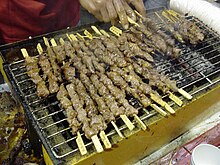
Chuan(Chinese:Xuyến;pinyin:chuàn), often referred to as "chuan" inMandarinthroughout the north, or kawap (كاۋاپ) inUyghur,is a variation of kebab originating from theUyghur peoplein the western province ofXinjiangand a popular dish inChinese Islamic cuisine.The dish has since spread across the rest of the country and become a popularstreet food.
Although the most traditional form of chuan uses lamb or mutton, other types of meat, such as chicken, beef, pork, and seafood, may be used as well. Small pieces of meat are skewered and either roasted or deep-fried. Common spices and condiments includecumincalled "ziran",pepper,sesame,andsesame oil.
Europe
[edit]Greece
[edit]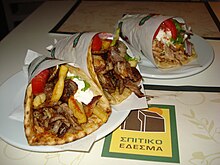
While the history ofstreet foodsinGreecegoes back to ancient times, the iconic Greekgyrosandsouvlakias it is known today arose only following the Second World War. Introduced toAthensin the 1950s by Greek refugees from Turkey and the Middle East, gyros was originally known simply asdöner kebab.It is typically served as a sandwich rolled inpitabread, or on a plate, with french fries and various salads and sauces such astzatziki.Later in the 1960s, vendors also began selling dishes in the same style made with souvlaki, which resembles Turkish shish kebab, but is usually made with pork.[15]
Around the same time, the Greek wordgyrosreplaceddöner kebab,and the Greek style of the dish spread to become popular, particularly in North America, and various other parts of the world.[16]
In contrast to other areas of Greece, in Athens, both types of sandwich may be calledsouvlaki,with the skewered meat being calledkalamaki.
Although gyros is unquestionably of Middle Eastern origin, the issue of whether modern-day souvlaki came to Greece via Turkish cuisine, and should be considered a Greek styling of shish kebab, or is a contemporary revival of Greek tradition dating as far back as 17th century BCMinoan civilization,[17]is a topic of sometimes heated debate, at least between Greeks and Turks.[18]While English speakers may refer to souvlaki skewers as kebabs,[19]they are not properly called that in Greece.
West Asia and North Africa
[edit]South Caucasus
[edit]Both Armenian and Azerbaijani cuisine feature oblong kofta-style mincemeats kebabs known aslula or lyulya kebab,while Armenian cuisinerefers to shish-style kebabs askhorovats,[20][21]and doner kebab asKarsi khorovatsafter the city ofKarswhich became known for the dish during the time of the Ottoman Empire.[21]
Iran
[edit]
There are several distinct Persian varieties of kabab (Persian:کباب). Kabab may be served with either steamed,saffronedbasmatior Persianriceand calledchelow kabab(چلوکباب), which is considered thenational dishof Iran.[22]It may also be served with the various types of bread that are the most commonly eaten in Iran, such aslavash.
It is served with the basicIranian meal accompaniments,in addition to grilled tomatoes on the side of the rice and butter on top of the rice. It is an old northern tradition (probably originating inTehran) that a raw egg yolk should be placed on top of the rice as well, though this is strictly optional, and most restaurants will not serve the rice this way unless it is specifically requested. "Somagh", powderedsumac,is also made available and its use varies based on tastes to a small dash on the rice or a heavy sprinkling on both rice and meat, particularly when used with red (beef/veal/lamb) meat.
At Persian restaurants, the combination of onekabab bargand onekabab koobidehis typically calledSoltani,meaning "sultan's feast". The combination of one kabab barg, onejujeh kababand kabab koobideh is typically calledShah abbasi,meaning "Shah Abbas'meal ". The traditional beverage of choice to accompany Persian kabab isdoogh,a sour yogurt drink with mint and salt.
In the oldbazaartradition, the rice (which is covered with a tin lid) and accompaniments are served first, immediately followed by the kababs, which are brought to the table by the waiter, who holds several skewers in his left hand, and a piece of flat bread (typically nan-e lavash) in his right. A skewer is placed directly on the rice and while holding the kebab down on the rice with the bread, the skewer is quickly pulled out. With the two most common kababs,bargandkoobideh,two skewers are always served. In general, bazaar kabab restaurants only serve these two varieties, though there are exceptions.
InIranian Azerbaijan,"Binab (also Bonab) Kababi" is very famous in Iranian Azerbaijani local cuisine for its large size.[23]It is named after the city of Binab in East Azerbaijan province. This kabab and other types (e.g., Shishlik, Kubide, Berge, Gelin, etc.) can be served alone or with rice and fresh salad on the side. In this region Kababs come usually with yogurt, hot bread, tomato, onion, parsley and paprika-salt, and tarragon.

Kabab koobideh(کباب کوبیده) itkūbide(کوبیده) is an Iranianmincedmeat kabab which is made from ground lamb, beef, or chicken, often mixed withparsleyandchopped onions.
Kabab Koobideh contains: ground meat, onion, salt, pepper, turmeric, and seasoning. These ingredients are mixed together until the mixture becomes smooth and sticky. One egg is added to help the mix stick together. The mixture is then pressed around a skewer. Koobideh Kabab is typically 18 to 20 centimeters (7–8 in) long.
Kabāb-e Barg(Persian:کباب برگ) is a Persian style barbecued lamb, chicken or beef kabab dish. The main ingredients ofKabab Barg– a short form of this name – are fillets of beef tenderloin, lamb shank or chicken breast, onions and olive oil.
Marinadeis prepared by the mixture of half a cup of olive oil, threeonions,garlic,half teaspoonsaffron,salt and black pepper. One kilogram of lamb is cut into 1 cm thick and 4–5 cm long pieces. It should be marinated overnight in refrigerator, and the container should be covered. The next day, the lamb is threaded on long, thin metal skewers. It is brushed with marinade and is barbecued for 5–10 minutes on each side.
Jūjeh Kabāb(جوجهکباب) consists of pieces of chicken firstmarinatedin minced onion and lemon juice withsaffronthen grilled over a fire. It is sometimes served with grilled tomato and pepper. Jujeh Kabab is one of the most popular Persian dishes.
Kabab Bakhtiariis a combination of Jujeh kabab (chicken kabab) and Kabab barg (beef or lamb meat) on the same skewer. Its name comes from theBakhtiari regionof Iran.
Kabab Kenjeh,also known as Chenjeh (کنجهکباب,چنجه) is a kabab traditionally made with chunks of marinated lamb meat. It is typically served with grilled tomatoes and rice or bread.[24]
Kabab Torshis an Iranian Kabab from the northern provinces of Gilan and Mazandaran, renowned for its sour, pomegranate based seasoning.[25]
Kabab Lari, Kabab Tabei (Pan Kabab), Dande Kabab, Kabab Shandiz, Shishlik Kabab, Kabab Ghafghazi, Uzun kabab of Tabriz, Doosh Kabab of Guilan, Chump (Jump) Kabab of Sistan, Kabab Toori of Tabriz, Kabob Golpayegan, Kabab Tanoorcheh of Baluchestan, Kabab Soltani, Kabob Vaziri, Kabob Loghmeh, Taas Kabab, Mahi Kabab (Fish Kabab) and Kabab Jegar (Sheep Liver Kaba ) are among other types of Persian Kababs popular in Iran.
Iraq
[edit]
Several types of kebab are popular inIraqi cuisine,although the word kebab in local use is reserved for skewers of spiced ground lamb, traditionally grilled on natural wood charcoal to give the kebab its special flavor. Skewers of grilled marinated meat chunks are called tikka.[6]
The Levant and Egypt
[edit]Several varieties of kebabs can be found inLevantine cuisine.Among the most common areshish taouk,which are grilled chicken skewers marinated in olive oil and spices, andlahem meshwi,charcoal-grilled skewers of prime lamb cubes lightly seasoned with herbs.[6]
Mizrahi Jewsbrought various types of grilled meat from their native Middle Eastern countries to Israel, where they have become an essential part ofIsraeli cuisine.[6]Among the most popular are skewers of elongated spiced ground meat, called kabab (Hebrew:קבב), which have become a staple dish of meat restaurants and the main dish of the traditional holiday barbecues, alongside theshishlik.They are commonly made of beef, though lamb is also occasionally used, and are almost always served with the localpitabread.
Shawarma,although not considered a kebab in most countries of the Levant and Egypt, is another very popular type of grilled meat preparation that characterizes this region.
Turkey
[edit]

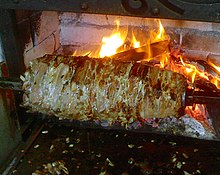

- Adana kebap(or kıyma kebabı) is a long, hand-minced meat kebab mounted on a wide iron skewer and grilled over charcoal. Named after the Turkish city ofAdana,the kebab is generally "hot" or piquant. The traditional Adana kebab is made using lamb, with a high fatty content cooked over hot coals. Only three ingredients are used in a proper Adana kebab, minced lamb, red capsicum (pepper) and salt.
- Ali Paşa kebabı,"Ali Pasha kebab" – cubed lamb with tomato, onion and parsley wrapped in phillo.[26]
- Alinazik– Ground meat kebab sautéed in a saucepan, with garlic, yogurt and eggplants added.
- Beyti kebap– Ground lamb or beef, seasoned and grilled on a skewer, often served wrapped inlavashand topped withtomato sauceandyogurt,traced back to the famous kebab houseBeytiinIstanbuland particularly popular in Turkey's larger cities.
- Bostan kebabı– Lamb and aubergine casserole.[26]
- Buğu kebabı– Steam kebab, is aTurkishstewwhich is cooked in a pan or an earthenware casserole. The casserole's lid is sealed in order to cook the meat in its own juices. The dish is prepared withpearl onions,garlic,thymeand other spices. InTekirdağ,it is served withcumin;inİzmir,it is served withmastic.[27]
- Cağ kebap,'spoke kebab' – Cubes of lamb roasted first on acağ(a horizontalrotating spit) and then on a skewer, a specialty ofErzurumregion with recently rising popularity.
- Ciğer kebabı,'liver kebab' - usually eaten with sliced onions, salad and bread.
- Çökertme kebabı– Sirloin veal kebap stuffed withyogurtand potatoes.
- Çöp şiş,"small skewer kebab" – a speciality ofSelçukandGermenciknearEphesus,pounded boneless meat with tomatoes and garlic marinated with black pepper,thymeand oil on wooden skewers.[28]
- Döner kebap,literally "rotating kebab" in Turkish, is sliced lamb, beef, or chicken, slowly roasted on a verticalrotating spit.The Middle Easternshawarma,Mexicantacos al pastor,and Greekgyrosare all derived from the Turkish döner kebab, which was invented inBursain the 19th century.[29]The German-style döner kebab sandwich, sometimes called simply "a kebab" in English, wasintroduced by Turkish immigrantsin Berlin in the 1970s, and has become one of the most populartake-awayfoods in Germany and much of Europe. It is commonly sold by Turks, and considered a Turkish-German specialty, in Germany.[30]
- Hünkâri kebabı,'Sultan's kebab' – Sliced lamb meat mixed withpatlıcan beğendi(aubergine purée), basil,thymeandbay leaf.[26]
- İskender kebap– döner kebab served withyogurt,tomato sauce andbutter,originated inBursa.This kebab was invented by İskender Efendi in 1867. He was inspired from Cağ kebab and turned it from horizontal to vertical.
- İslim kebabı,'steamed kebab' – Another version of the aubergine kebab without its skin, marinated in sunflower oil.[26][28]
- Kağıt kebabı– Lamb cooked in a paper wrapping.[28]
- Kuzu şiş– Shish prepared with marinated milk-fed lamb meat.
- Manisa Kebab– This Manisa region version of the kebab is smaller and flat size shish meat on the sliced pide bread, flavored with butter, and stuffed with tomato, garlic and green pepper.
- Patlıcan kebabı,'aubergine kebab' – Special kebap meat marinated in spices and served witheggplant(aubergine), hot pide bread and a yogurt sauce.[28]
- Shish kebap– is a dish consisting of small cubes of meat or fish threaded on askewerandgrilled.Şiş,pronounced[ʃiʃ],is a Turkish word meaning "sword" or "skewer".[31][32]According to tradition, the dish was invented by medieval soldiers who used their swords to grill meat over open-field fires.[33][34]In Turkey, shish kebab does not normally contain vegetables, though they may be cooked on a separate skewer.[35]It can be prepared with lamb, beef, chicken, or fish, but pork is not used. Lemon is used in some parts of Turkey if the meat selection is chicken.[36]ThePontian Greeksmade a dish similar to shish kebabs, although theirs were cooked in a saucepan.[37][38]
- Tavuk şiş–Yogurt-marinatedchicken grilled on a stick.[28]
- Testi kebabı,'earthenware-jug kebab' – is a dish fromCentral Anatoliaand the Mid-WesternBlack Sea region,consisting of a mixture of meat and vegetables cooked in a clay pot or jug over fire (testimeansjugin Turkish). The pot is sealed with bread dough or foil and is broken when serving.[39]
South Asia
[edit]
South Asia has a rich kebab tradition with a great variety of different kebab dishes. Many modern kebabs inBangladeshi,IndianandPakistani cuisinetrace their origins back to the time of theMughalsand the strong influence ofMughlai cuisine.Kebab dishes common to one or more of these countries include:
- Tandoori kebab(Urdu:تندوری کباب)
- Naga doner kebab
- Tikka kebab
- Kathi Kebab(includingPorotaKababs, kebab wraps)
- Shami kebab(Urdu:شامی کباب) - A Shami kebab is a small patty of mincedbeeforchickenand groundchickpeasand spices.
- Seekh kebab(Urdu:سيخ کباب) - A long skewer of beef mixed with herbs and seasonings, it takes its name from the skewer.
- Tunde ke kabab(Urdu:ٹنڈے کے کباب)
- Bun kebab(Urdu:بن کباب) - A unique kebab sandwich with beef, lamb, fish or chicken.
- Shatkora doner kebab
- Chapli kebab(Urdu:چپلی کباب) - A spiced, tangy round kebab made of ground beef and cooked in animal fat. A speciality ofPeshawarinKhyber-Pakhtunkhwa.
- Bihari kebab(Urdu:بہاری کباب) - Skewer of beef mixed with herbs and seasoning.
- Kalmi kebab(Urdu:کلمی کباب)
- Sheesh kebab(Urdu:شیش کباب)
- Burrah kebab- made from goat or lamb chops, liberallymarinatedwith spices and charcoal grilled.
Afghanistan
[edit]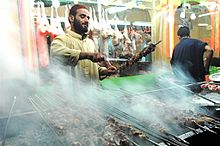
Afghan kebab (Pashto/Dari:کباب) is most often found in restaurants and outdoor vendor stalls. The most widely used meat is lamb. Recipes differ with every restaurant. InAfghan cuisine,kebab is served with naan, rarely rice, and customers have the option to sprinklesumacorghora,dried ground sour grapes, on their kebab. The quality of kebab is solely dependent on the quality of the meat. Pieces of fat from the sheep's tail (jijeq) are usually added with the lambskewersto add extra flavor.
Other popular kebabs include thelamb chop,ribs,beef,buffalo,and chicken, all of which are found in better restaurants.
Chapli kebab,a specialty of Eastern Afghanistan, is a patty made from beef mince. It is prepared flat and round, and served with naan. The original recipe of chapli kebab dictates a half meat (or less), half flour mixture, which renders it lighter in taste and less expensive.
Bangladesh
[edit]
In Bangladesh they make variations of kebab (Bengali কাবাব or "Kabab" ). In the oldMughalprovince ofBengal Subah's capital of Dhaka, various Pakistani and Indian-influenced dishes started to be made. Amongst these were kebabs. InBangladeshi cuisine,most kebabs are made using fish or beef.
India
[edit]Modern-day kebabs in India mostly trace their origin to the influence ofMughlai cuisine.[3]Some Indian kebabs have very specific geographic attributions, such as Kakori kebab, which is made of finely ground, soft mince and attributed to the city ofKakoriinUttar Pradesh,where legend has it that it was first prepared for old and toothless pilgrims.[40]
Pakistan
[edit]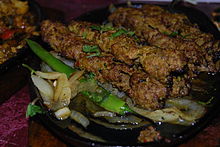
In Pakistan kebabs trace back their origin during the time of the MughalsMughlai cuisine,and their influence on thecuisine of modern-day Pakistan.There are all sorts of kebab varieties such as seekh, chapli, shammi and other forms of roasted and grilled meats. As Pakistan is a predominantly Muslim country, pork is not used. Instead meats likebeef,chicken,lamb,fish and sometimesbuffare used in the making of kebabs.
Southeast Asia
[edit]
Satayis a kebab of seasoned, skewered, and grilled meat, served with a sauce.[41]It is a dish ofSoutheast Asia,particularly Indonesia, Malaysia, and Thailand.[42]
Satay may consist of diced or sliced chicken, goat, lamb, mutton, beef, pork, fish, other meats, ortofu.Traditionally skewers from the midrib of thecoconutpalm frond are used, althoughbambooskewers are often used instead. It is grilled or barbecued over a wood or charcoal fire with spicy seasonings. It may be served with various sauces, though most often a combination ofsoyandpeanut sauce.[43]Hence, peanut sauce is often called satay sauce.[44]
Satay was developed byJavanesestreet vendors as a unique adaptation of Indian kebab.[42][45]The introduction of satay, and other now-iconic dishes such astongsengandgulaikambingbased on meats such as goat and lamb, coincided with an influx ofIndianandArabtraders and immigrants starting in the 18th century.[46]It is available almost anywhere in Indonesia, where it has become anational dish.[47][48][49]In Sri Lanka, it has become a staple of the local diet as a result of theinfluences from the local Malay community.[50]
Sub-Saharan Africa
[edit]South Africa
[edit]Sosatie(pluralsosaties) is a traditionalSouth Africandish of meat (usually lamb or mutton) cooked on skewers.[51]The term derives fromsate( "skewered meat" ) andsaus(spicy sauce). It is ofCape Malayorigin. Sosatie recipes vary, but commonly the ingredients can include cubes of lamb, beef, chicken, dried apricots, red onions and mixed peppers.
West Africa
[edit]Suyais a spicy kebab which is a popular food item in West Africa that originated inNigeria.[52][53]It is traditionally prepared by theHausa peopleofNigeria,Cameroon,Niger,Ghanaand some parts of Sudan (where it is calledagashe).
Kyinkyingais common and popular inWest Africa.[54][55]It is aGhanaiandish,very similar to or synonymous with the Hausasuyakebab, also known assooya, tsinga, chichinga, tsire agashi, chachangaortankora.[56][57][58]
Other variants
[edit]Ćevapi
[edit]Ćevapi(pronounced[tɕɛv̞ǎːpi]) orćevapčići(formaldiminutive,[tɕɛv̞ǎptʃitɕi],ћевапчићи), which comes from the wordkebab,is a grilled dish of minced meat, a type of skinless sausage, found traditionally in the countries ofsoutheastern Europe(theBalkans). They are considered a national dish inBosnia and Herzegovina[59]andSerbia[60][61][62]and are also common inCroatia,Kosovo,Montenegro,Albania,Slovenia,as well as inNorth Macedonia,Bulgaria,Romania.Ćevapi has its origins inBosnia and Herzegovinaduring theOttoman period,and represents a regional speciality similar to thekofte kebab.A dish with similar origins is in Romania calledmititei.[63]
Pinchitos
[edit]PinchitosorPinchos Morunosis aMoorish-derived kebab dish inSpanish cuisine.The namepinchitosis used in the southernSpanish autonomous communitiesofAndalusiaandExtremadura.They consist of small cubes of meat threaded onto a skewer (Spanish:pincho) which are traditionally cooked overcharcoalbraziers. Similar dishes in North Africa or otherMuslim majority countriestend to be lamb-based, but pork and chicken are the most popular meats for the dish in Spain. Pinchitos are also extremely popular in Venezuela, due to the heavy influence Spain had in Venezuelan cuisine during many years.
Shashlik
[edit]Shashlikis similar to, or sometimes a synonym for, shish kebab. It is popular in many countries, particularly inEastern and Central Europe,theCaucasus,and theBaltics.In non-Muslim-majority countries, shashlik and equivalent dishes likeRomanianfrigărui[6]may sometimes be prepared with pork.
Kebab in Western culture
[edit]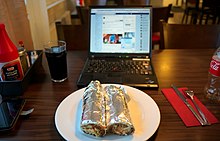
Kebab cuisine has spread around the world together with Muslim influence.[3]Although non-MuslimWesternersmay be increasingly familiar with some of the many other international kebab dishes, only two have become an established and widely popular part of the culture in many Western countries. In English, the wordkebabcommonly refers toshish kebaband, outside of North America, todöner kebabor related fast-food dishes.[6]These dishes are also served in many other countries, where they may have different names.[64][65]
Kebabs have also met opposition: in Italy, several cities banned kebab shops in order to preserve Italian culinary culture.[66][67]Many protested against these bans as "racist".[66]
Shish kebab
[edit]
In English,kebab,or in North America alsokabob,often occurring asshish kebab,is now a culinary term for small pieces of meat cooked on a skewer.[3]The wordkebab,most likely derived from Persian,[8]has been used with various spellings in this sense since at least the 17th century,[13]while theOxford English Dictionaryrecords the earliest known publication of the termshish kebab,derived fromTurkish:şiş kebap,in 1914.[68] There are two etymologies suggested for Shish Kabob in the Persian dictionary of Dehkhoda: Shish being the Persian word "Shish" for the number 6, which refers to the original six pieces of meat of a standard Kabob skewer, or "Shish" being driven from Late Middle Persian "Sich" meaning a skewer. The word "Kabob" is most probably driven from the Arhameic word kbābā (to roast).[69] In many English-speaking countries, it refers to the now well-known dish prepared with marinated meat or seafood together with vegetables such as onions, tomatoes, and bell peppers threaded onto the skewer, also sometimes known asshashlik.[70]This preparation is different from the typical Turkish shish kebab style, where vegetables are usually cooked on a separate skewer.[35]Shish kebabs are customarily prepared in homes and restaurants, and are usually cooked on a grill or barbecue, or roasted in an oven.
The wordkebabmay also be used as a general term in English to describe any similar-looking skewered food, such asbrochette,satay,souvlaki,yakitori,or numerous small chunks of any type of food served on a stick. This is different from its use in the West Asia, whereshish(Persian/Mazandarani:شیش,Turkish:şiş) is the word for skewer, whilekebabcomes from the word for grilling.[6]
Doner kebab
[edit]
English speakers from countries outside North America may also use the wordkebabgenerally to mean the popularfast foodversion of the Turkish döner kebab,[64]or the related shawarma or gyros, and the sandwiches made with them, available fromkebab shopsas take-away meals. This usage may be found in some non-English parts of Europe as well. In North America, the Greek variant gyros is most widely known.
The döner kebab originated in 19th century Turkey, but it became widely popular in the West only in the latter half of the 20th century. Many layers of meat are stacked onto a large vertical rotating spit; the outer surface is gradually cooked and sliced off, and typically served either mixed or topped with vegetables and sauces in a sandwich made withpitaor otherflatbreads.Certain regional variants also include cheeses. Sandwiches served in the same manner, but with other meats or cheese, may also sometimes be called a "kebab". It is available in most parts of Europe, and many other countries, though sometimes with different names or serving styles. In Germany, the highly popular sandwich, introduced by Turkish immigrants, is called aDöner,though Arab shops there serveshawarma.[71]
Similar dishes
[edit]
|
|
|
|
See also
[edit]References
[edit]- ^Marks, Gil (17 November 2010).Encyclopedia of Jewish Food.HMH.ISBN978-0-544-18631-6.
The Persian term was adopted by medieval Arabs and Turks as kebab
- ^ab"kebab – definition of kebab in English".Oxford Dictionaries.Oxford University Press. Archived fromthe originalon 3 August 2017.Retrieved3 August2017.
- ^abcdefghiDavidson, Alan (2014). Jaine, Tom (ed.).The Oxford Companion to Food.Oxford: Oxford University Press. p. 442.ISBN9780191040726– via Google Books.
- ^Akin, Engin (6 October 2015).Essential Turkish Cuisine.Abrams.ISBN9781613128718– via Google Books.
- ^Nasrallah, Nawal (2007).Annals of the caliphs' kitchens: Ibn Sayyār al-Warrāq's tenth-century Baghdadi cookbook.Brill.p. 40.ISBN9789047423058.
- ^abcdefghijkMarks, Gil(2010).Encyclopedia of Jewish Food.Houghton Mifflin Harcourt.ISBN978-0-544-18631-6.
- ^Achaya, K. T. (1998).A Historical Dictionary of Indian Food.Delhi: Oxford University Press. p. 115.
- ^abcdZubaida, Sami(2010)."Vocabularies of Middle Eastern Food".In Hosking, Richard (ed.).Food and Language: Proceedings of the Oxford Symposium on Food and Cooking 2009.Oxford Symposium on Food and Cookery.Prospect Books.p. 386.ISBN978-1-903018-79-8– via Google Books.
- ^"Nişanyan Sevan, Sözlerin Soyağacı, Çağdaş Türkçenin Etimolojik Sözlüğü".Archivedfrom the original on 22 September 2013.Retrieved6 July2013.
- ^The Editors of the American Heritage Dictionaries."Appendix II – Semitic Roots".American Heritage Dictionary.Houghton Mifflin Harcourt.Retrieved5 June2016.
- ^Vladimir Orel;Olga V. Stolbova (1995).Hamito-Semitic Etymological Dictionary: Materials for a Reconstruction.E. J. Brill.pp.307.ISBN978-9004100510.
- ^Shilcutt, Katharine (9 April 2014)."World's Second-Largest Döner Kebap Chain Headed to Houston".Houstonia Magazine.Retrieved19 June2020.
- ^ab"cabob".Oxford English Dictionary(2nd ed.).Oxford University Press.1989.
- ^ "Kebab".Dictionary.com.Retrieved23 February2016.
- ^ Matalas, Antonia-Leda; Yannakoulia, Mary (2000)."Greek Street Food Vending: An Old Habit Turned New".InSimopoulos, Artemis P.;Bhat, Ramesh Venkataramana (eds.).Street Foods.Karger Medical and Scientific Publishers. p. 6.ISBN978-3-8055-6927-9.
- ^ "The Gyro, a Greek Sandwich, Selling Like Hot Dogs".The New York Times.4 September 1971. p. 23.Retrieved22 February2016.
- ^ Tassoula Eptakili (9 October 2015)."Prehistoric Gastronomy".Greece Is.Retrieved21 February2016.
- ^
Gold, David L. (2009).Studies in Etymology and Etiology With Emphasis on Germanic, Jewish, Romance and Slavic Languages.Universidad de Alicante. p. 323.ISBN978-84-7908-517-9.
Greeks and Turks also battle over the similar dishes which the first callsoublaki(> englishsouvlaki) and the secondşiş kebabı(> Englishshish kebab), each claiming to be the originators.
- ^ "Souvlaki (Wicked kebabs)".Jamie Oliver Recipes.Retrieved22 February2016.
- ^Petrosian, Irina (2011). Albala, Ken (ed.).Food Cultures of the World Encyclopedia.Vol. 4: Europe. ABC-CLIO. pp. 1–10.ISBN9780313376269– via Google Books.
- ^abPetrosian, Irina; Underwood, David (2006).Armenian Food: Fact, Fiction & Folklore.Yerkir Publishing.ISBN9781411698659– via Google Books.
- ^Shaida, Margaret (1992).Chellow Kabab – The National Dish of Iran.Oxford Symposium on Food and Cookery 1991: Public Eating. [London]: Prospect Books. p. 272.ISBN9780907325475.Retrieved21 April2018.
- ^"5,000 Bonab Kebabs per Day".Financial Tribune Daily.1 March 2015. Archived fromthe originalon 11 August 2016.Retrieved13 June2016.
- ^Dana-Haeri, Jila (2014).From a Persian kitchen: fresh discoveries in Iranian cooking.London: I.B.Tauris. pp. 117–118.ISBN9781780768014.OCLC859880780.
- ^"Kabab Torsh".thecaspianchef.21 May 2019.
- ^abcdTurkish Cookeryby M.GünürISBN975-479-100-7
- ^Kebab aux petits oignonsArchived14 January 2015 at theWayback Machine,Turkish Ministry of Culture and Tourism
- ^abcdeThe Complete Book of Turkish Cooking,A.Algar (1985)ISBN0-7103-0334-3
- ^Kenneth F. Kiple, Kriemhild Coneè Ornelas, eds.,Cambridge World History of Food,Cambridge, 2000.ISBN0-521-40216-6.Vol. 2, p. 1147.
- ^"Doner kebab 'inventor' Kadir Nurman dies in Berlin".BBC.Retrieved1 November2013.
- ^Glenn Randall Mack, Asele Surina (2005).Food culture in Russia and Central Asia.Greenwood Publishing Group. pp. 83–84.ISBN9780313327735.
- ^Internet dictionaryArchived14 January 2013 at theWayback MachineofTurkish Language Association
- ^Food Around the World, p.45, Oxford University Press, 1986,Check on Google BooksArchived1 November 2022 at theWayback Machine
- ^Middle Eastern Kitchen, Ghillie Basan Hippocrene Books, 2007, p.70,Check on Google Books
- ^abSteven Raichlen (28 May 2008).The Barbecue! Bible 10th Anniversary Edition.Workman Publishing Company. pp. 214–.ISBN978-0-7611-5957-5.
- ^"Authentic Turkish Chicken Kebab".Aiflyr. 13 July 2024.<
- ^"Pontian pork skewers with atzika and tsatsibeli".Pontos News. 17 April 2020.
- ^The Rough Guide to Europe on a Budget.Rough Guides. 2017.ISBN9780241307816.
Slightly up-market though still good value, sleek kebab restaurant, serving Armenian and Pontian dishes.
- ^Testi kebab: a specialty of CappadociaArchived20 November 2008 at theWayback Machine.Retrieved on 22 May 2009 (scroll to the bottom of the page)
- ^Jiggs, Kaira (2005).Jiggs Kalra's Classic Cooking Of Avadh.Allied Publishers. p. 14.ISBN978-81-7764-567-5.
- ^"Grilled Beef Satay".Food Reference.com.Retrieved6 July2010.
- ^abAlan., Davidson (2006).The Oxford Companion to Food(2nd ed.). Oxford: OUP Oxford.ISBN9780191018251.OCLC862049879.
- ^Marx, Pamela (1996).The Travel-the-world Cookbook.Good Year Books. p.30.ISBN9780673362544.
indonesian satay peanut sauce.
- ^"Peanut butter and satay sauce – recipe".The Guardian.2 May 2014.
- ^Bruce Kraig; Colleen Taylor Sen (2013).Street Food Around the World: An Encyclopedia of Food and Culture.ABC-CLIO. p. 183.ISBN9781598849554.
- ^Christina Andhika Setyanti (30 August 2016)."Sepotong Sejarah Autentik Indonesia dalam Semangkuk Tongseng".CNN Indonesia(in Indonesian).
- ^Sara Schonhardt (25 February 2016)."40 Indonesian foods we can't live without".CNN.
- ^Owen, Sri (1999).Indonesian Regional Food and Cookery By Sri Owen.Frances Lincoln.ISBN9780711212732.Retrieved7 July2010.[permanent dead link]
- ^Sara Schonhardt and Melanie Wood (15 August 2011)."40 of Indonesia's best dishes".CNN Travel.Retrieved6 July2014.
- ^Bullis, Douglas; Hutton, Wendy (1 April 2001).Food of Sri Lanka.Tuttle.ISBN9781462907182.
- ^Raichlen, S. (2015).Planet Barbecue!: 309 Recipes, 60 Countries(in German). Workman Publishing Company. p. 251.ISBN978-0-7611-6447-0.Retrieved26 May2017.
- ^Fareeda Abdulkareem (23 February 2017)."A Brief History of Suya, West Africa's Answer to Shish Kebab".Culture Trip.Retrieved24 August2021.
- ^EKE, IRABOR,OKOYE; et al."THE MICROBIAL STATUS OF COMMERCIAL 'SUYA' MEAT PRODUCTS IN EKPOMA, EDO, NIGERIA"(PDF).International Journal of Community Research.Archived fromthe original(PDF)on 24 September 2021.Retrieved5 April2014.
{{cite web}}:CS1 maint: multiple names: authors list (link) - ^Raichlen, S. (2015).Planet Barbecue!: 309 Recipes, 60 Countries.Workman Publishing Company. p. 38.ISBN978-0-7611-6447-0.Retrieved23 May2016.
- ^Raichlen, S.; Fink, B. (2008).The Barbecue! Bible.Workman Pub. pp. 157–158.ISBN978-0-7611-4943-9.Retrieved23 May2016.
- ^Osseo-Asare, Fran (2005).Food culture in sub-Saharan Africa.Greenwood Press. p. 41.OCLC58527114.
- ^Dako, Kari (2003).Ghanaianisms: a glossary.Accra: Ghana Universities Press. pp. 59, 201.ISBN9789964303013.OCLC53432897.
- ^Adjonyoh, Zoe(2017).Zoe's Ghana Kitchen.UK: Hachette.ISBN9781784721985.
- ^"Bosnia and Herzegovina".Encyclopædia Britannica. 2009.Retrieved27 July2009.
- ^Encyclopædia Britannica (2002).The New Encyclopædia Britannica.Vol. 1. Encyclopædia Britannica.ISBN978-0-85229-787-2.
- ^Ember, Melvin; Ember, Carol R (2001).Countries and Their Cultures: Saint Kitts and Nevis to Zimbabwe.Macmillan Reference USA. p. 68.ISBN9780028649467.
- ^"Serbian cuisine".TravelSerbia.Retrieved9 August2010.
- ^"Reteta originala de mititei de la Caru cu Bere".Ceva Bun(in Romanian). 21 May 2009.Retrieved14 January2018.
- ^ab"kebab Definition in the Cambridge English Dictionary".The Cambridge English Dictionary.Retrieved23 February2016.
- ^Prosper Montagne, ed. (2001).Larousse Gastronomique.New York: Clarkson Potter. p. 646.ISBN978-0-609-60971-2.
- ^abChantal Saint-Blancat (2014). "Italy". In Jocelyne Cesari (ed.).The Oxford Handbook of European Islam.p. 276.
One of the best ways to preserve Italian traditions and culinary culture has been the 'anti-kebab regulations' introduced in Brescia and Bergamo, in Bussolengo closed to Venice, and in Prato and Lucca in Tuscany...Italian civil society reacted firmly to these discriminatory practices... formed a coalition of protest against 'racist acts' and 'apartheid climax' using the defence of human rights
- ^"Italian town's kebab ban enrages migrant community".7 August 2011.
- ^"shish kebab".Oxford English Dictionary(2nd ed.).Oxford University Press.1989.
- ^ "Kabob - Dehkhoda".Vajehyab(in Persian).Retrieved4 August2023.
- ^ "Shashlik – definition of shashlik by The Free Dictionary".The Free Dictionary.Retrieved23 February2016.
- ^Doner kebab becomes Germany's favorite fast foodArchived27 April 2016 at theWayback Machine,USAToday,4/11/2010
- Kebabs
- Skewered foods
- Spit-cooked foods
- Street food
- Ancient dishes
- Arab cuisine
- Balkan cuisine
- Central Asian cuisine
- Levantine cuisine
- Ottoman cuisine
- South Asian cuisine
- Types of food
- Middle Eastern grilled meats
- Pontic Greek cuisine
- Middle Eastern cuisine
- Turkish cuisine
- Azerbaijani cuisine
- Israeli cuisine
- Belizean cuisine




